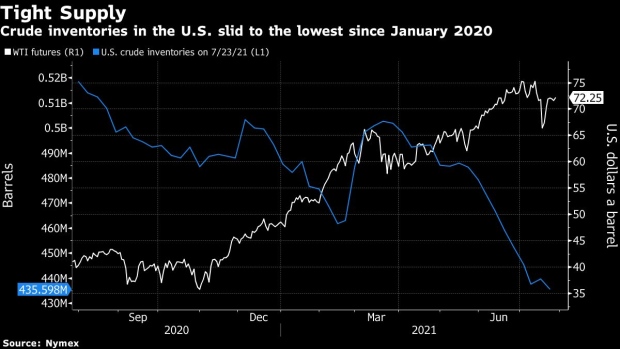Jul 28, 2021
Oil climbs as U.S. supplies tumble in peak demand season
, Bloomberg News
The Saudi Energy Minister sees himself as the central banker of oil: Helima Croft
Oil advanced to the highest level in two weeks after declining stockpiles of U.S. crude, gasoline and distillate signaled healthy demand during the nation’s summer driving season.
Futures rose 1 per cent in New York on Wednesday. A U.S. government report showed crude supplies slid to the lowest since January 2020 and distillate stockpiles posted the biggest decline since April. Fuel inventories fell by more than 2 million barrels last week, the data showed.
U.S. demand is “pretty healthy from an inventory perspective,” said Brian Kessens, a portfolio manager at Tortoise, a firm that manages roughly US$8 billion in energy-related assets. While the delta variant bears watching, in the U.S. “to date, it hasn’t had any impact on mobility at all,” he said.

Global oil prices have rallied this year with an economic recovery underway following vaccine campaigns. However, the delta variant’s recent surge is posing a threat to the commodity’s rally -- and short-term demand -- as a rapidly rising case count has led many countries to impose restrictions.
“The oil market is just waiting for the moment to get the all-clear signal that the delta variant risk is just a blip on the overall outlook,” said Ed Moya, senior market analyst at Oanda Corp.
Deutsche Bank sees Brent prices at US$72 in the second half of this year, as speculative interest wanes but the market remains supported by deficits averaging 900,000 barrels per day through the rest of the year, said analyst Michael Hsueh in a recent note to clients.
Prices
- West Texas Intermediate for September delivery rose 74 cents to settle at US$72.39 a barrel on the New York Mercantile Exchange.
- Brent for September settlement gained 26 cents to end the session at US$74.74 on the ICE Futures Europe exchange.
The EIA data also showed jet fuel demand rising in the U.S., with the moving average climbing to about 1.5 million barrels a day, the highest since March 2020. Inventories at the nation’s largest storage hub in Cushing, Oklahoma, slid to the lowest level in more than a year.
Meanwhile, returns from converting crude into gasoline have surged in recent weeks from the U.S. to Asia, where they’ve hit the highest level since April 2019. However, the spread of the delta variant has presented a challenge to refiners ready to put the worst of the COVID-19 pandemic behind them. Processors want to cash in on better margins, but are wary that renewed demand weakness could lead to a surplus of fuels and sink profits again.
Other market news:
- Petroleos Mexicanos posted higher oil output in the second quarter as it seeks to reverse long-term production declines and reduce debt.
- Some Middle Eastern oil producers are seeing crude pegged to their own official selling prices sliding into discounts in the Asian spot market, with the shift driven both by a slowdown in Chinese crude purchases and high OSPs.
- Investors just pulled a net US$128.7 million from one of the world’s biggest oil exchange-traded funds as the ongoing spread of the delta variant has slowed oil’s rally.


